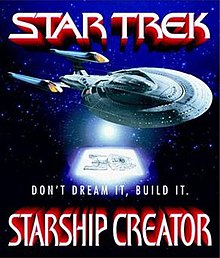The fictional technology in Star Trek has borrowed many ideas from the scientific world. Episodes often contain technologies named after or inspired by real-world scientific concepts, such as tachyon beams, baryon sweeps, quantum slipstream drives, and photon torpedoes. Some of the technologies created for the Star Trek universe were done so out of financial necessity. For instance, the transporter was created because the limited budget of Star Trek: The Original Series (TOS) in the 1960s did not allow expensive shots of spaceships landing on planets.
Enterprise or USS Enterprise, often referred to as the Starship Enterprise, is the name of several fictional spacecraft, some of which are the main craft and setting for various television series and films in the Star Trek science fiction franchise. The most notable were Captain James T. Kirk's USS Enterprise (NCC-1701) from the original 1960s television series, and Captain Jean-Luc Picard's USS Enterprise (NCC-1701-D) from Star Trek: The Next Generation.

USS Voyager(NCC-74656) is the fictional Intrepid-class starship which is the primary setting of the science fiction television series Star Trek: Voyager. It is commanded by Captain Kathryn Janeway. Voyager was designed by Star Trek: Voyager production designer Richard D. James and illustrator Rick Sternbach. Most of the ship's on-screen appearances are computer-generated imagery (CGI), although models were also sometimes used. The ship's motto, as engraved on its dedication plaque, is a quote from the poem "Locksley Hall" by Alfred, Lord Tennyson: "For I dipt in to the future, far as human eye could see; Saw the vision of the world, and all the wonder that would be."
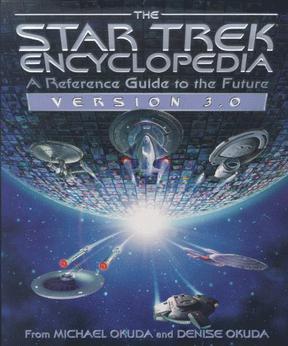
The Star Trek Encyclopedia: A Reference Guide to the Future is a 1994 encyclopedia of in-universe information from the Star Trek television series and films. It was written by Michael Okuda and Denise Okuda, who were production staff on Star Trek: The Next Generation, Star Trek: Deep Space Nine and Star Trek: Voyager and Debbie Mirek. It was illustrated by Doug Drexler.
In the Star Trek franchise, the Klingon Empire makes use of several classes of starships. As the Klingons are portrayed as a warrior culture, driven by the pursuit of honor and glory, the Empire is shown to use warships almost exclusively and even their support ships, such as troop transports and colony ships, are armed for battle. This contrasts with the exploration and research vessels used by Starfleet, the protagonists of the franchise. The first Klingon ship design used in The Original Series, the D7-class battlecruiser, was designed by Matt Jefferies to evoke a shape akin to that of a manta ray, providing a threatening and instantly recognizable form for viewers. The configuration of Jefferies's design featured a bulbous forward hull connected by a long boom to a wing-like main hull with the engine nacelles mounted on each wingtip. Though a variety of Klingon ships have appeared in Star Trek, their design generally conforms to this style. Most Klingon vessels were physically built as scale models, although later computer-generated imagery was used to create the models. In recent years, many of the original studio models have been sold at auctions.
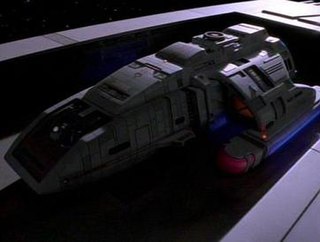
Runabouts are a fictional class of small, multi-purpose starships appearing in the Star Trek science-fiction franchise, primarily the television series Star Trek: Deep Space Nine, which aired on syndicated television between 1993 and 1999. They served as a means of transport for the crew of the fictional space station Deep Space Nine, in the early seasons of the series enabling storylines taking place away from the station.

USS Enterprise (NCC-1701-D), or Enterprise-D, to distinguish it as the fifth Federation vessel with the same name, is a starship in the Star Trek media franchise. Under the command of Captain Jean-Luc Picard, it is the main setting of Star Trek: The Next Generation (1987–1994) and the film Star Trek Generations (1994). It has also been depicted in various spinoffs, films, books, and licensed products.

Enterprise (NX-01) is the fictional spaceship that serves as the primary setting of the American science fiction television series Star Trek: Enterprise. The ship predates the other Starfleet ships named Enterprise and was first seen in the pilot episode "Broken Bow". Its missions included an initial period of deep space exploration and a mission into the Delphic Expanse following the Xindi attack on Earth; it was also instrumental in the formation of the United Federation of Planets with the Vulcans, Andorians and Tellarites.
Shuttlecraft are fictional vehicles in the Star Trek science fiction franchise built for short trips in space, such as between a planetary surface and orbit. Also referred to as shuttles, their introduction preceded the development of the Space Shuttle.
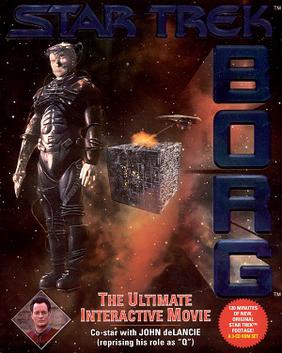
Star Trek: Borg is an interactive movie PC game and audiobook set in the Star Trek universe. It was written by Hilary Bader, directed by James L. Conway, and featured an original score by Dennis McCarthy. It was released in 1996 by Simon & Schuster for PC and Macintosh.

Michael Okuda is an American graphic designer best known for his work on Star Trek including designing futuristic computer user interfaces known as "okudagrams".
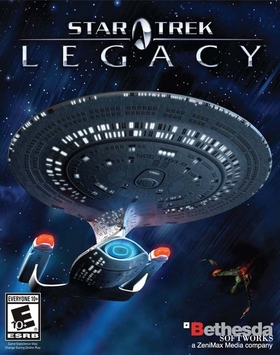
Star Trek: Legacy is a 2006 real-time tactics space combat video game for Microsoft Windows and Xbox 360 developed by Mad Doc Software and published by Bethesda Softworks in association with CBS Paramount Television and CBS Consumer Products. Originally slated for release in the fall of 2006 to coincide with the 40th anniversary of Star Trek, the Windows version was not released in North America until December 5, 2006, and the Xbox 360 version until December 15. In Europe, both the PC version and the Xbox 360 version were released on December 22, 2006.

A wormhole is a postulated method, within the general theory of relativity, of moving from one point in space to another without crossing the space between. Wormholes are a popular feature of science fiction as they allow faster-than-light interstellar travel within human timescales.
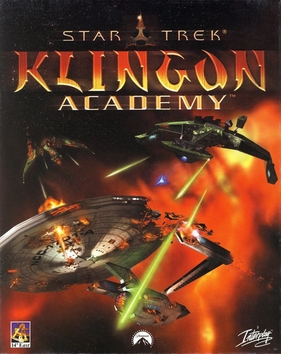
Star Trek: Klingon Academy is a space flight simulator video game developed by 14 Degrees East, an internal development house of publisher Interplay Entertainment. The game follows a young Klingon warrior named Torlek as he attends the Elite Command Academy, a war college created by General Chang to prepare warriors for a future conflict with the United Federation of Planets. Christopher Plummer and David Warner reprised their respective roles as Chang and Gorkon for the production of Klingon Academy.

Star Trek: Encounters is a video game set in the Star Trek fictional universe, which was released in 2006 for the PlayStation 2. The game was developed by Scottish studio 4J Studios for Bethesda Softworks and Ubisoft (EU).

Star Trek: Starship Creator Warp II is an American computer-based vehicle simulation game released by Simon & Schuster Interactive in 2000, as a sequel to Star Trek: Starship Creator (1998). The game is backwards compatible with its predecessor, and allows for ships to be imported into the multi-player mode of Star Trek: Deep Space Nine: Dominion Wars (2001). The game allows the user to create their own starships, crew them with personnel from the Star Trek universe, and send them on missions.
The Star Trek franchise features many spacecraft. Various space vessels make up the primary settings of the Star Trek television series, films, and expanded universe; others help advance the franchise's stories. Throughout the franchise's production, spacecraft have been depicted by numerous physical and computer-generated models. Producers worked to balance often tight budgets with the need to depict convincing, futuristic vessels.

Star Trek Timelines is a strategy role playing video game developed by Disruptor Beam for iOS and Android devices, Facebook, Facebook Gameroom, the Amazon Store, and Steam. On March 4, 2020 Tilting Point acquired the game from Disruptor Beam and created a new studio Wicked Realm Games to support the title. The player is the captain of a ship and can form their ship's crew from characters from any era of Star Trek, while steering the fate of the galaxy through diplomacy, science and force of arms.
